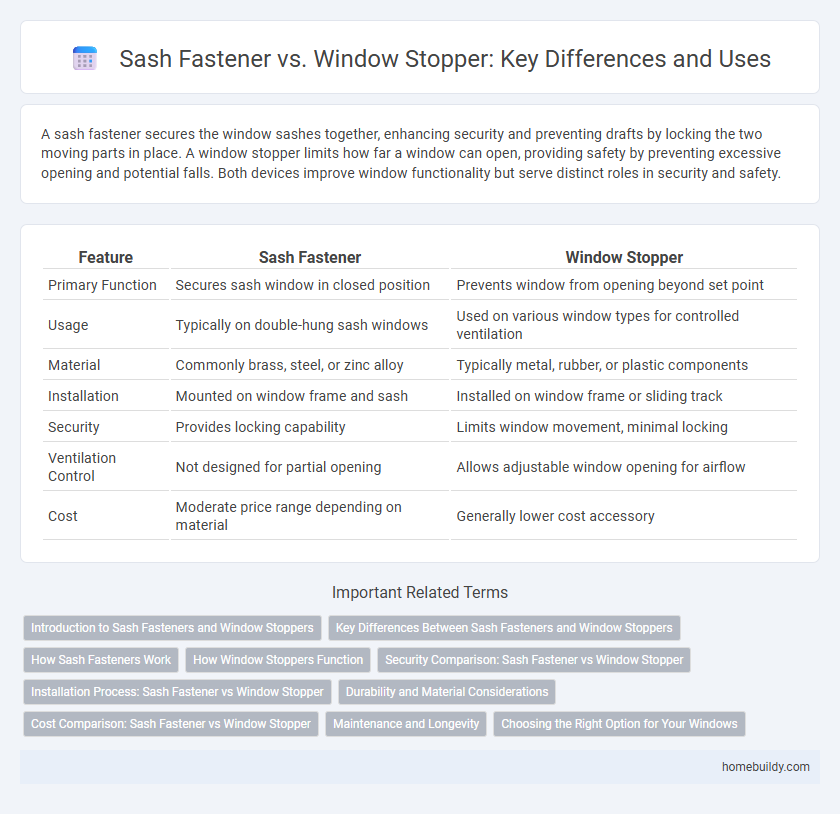A sash fastener secures the window sashes together, enhancing security and preventing drafts by locking the two moving parts in place. A window stopper limits how far a window can open, providing safety by preventing excessive opening and potential falls. Both devices improve window functionality but serve distinct roles in security and safety.
Table of Comparison
| Feature | Sash Fastener | Window Stopper |
|---|---|---|
| Primary Function | Secures sash window in closed position | Prevents window from opening beyond set point |
| Usage | Typically on double-hung sash windows | Used on various window types for controlled ventilation |
| Material | Commonly brass, steel, or zinc alloy | Typically metal, rubber, or plastic components |
| Installation | Mounted on window frame and sash | Installed on window frame or sliding track |
| Security | Provides locking capability | Limits window movement, minimal locking |
| Ventilation Control | Not designed for partial opening | Allows adjustable window opening for airflow |
| Cost | Moderate price range depending on material | Generally lower cost accessory |
Introduction to Sash Fasteners and Window Stoppers
Sash fasteners secure window sashes by locking them in place, enhancing safety and energy efficiency. Window stoppers physically limit window opening to prevent overextension and improve child safety. Both components are essential for maintaining window functionality and security in residential and commercial settings.
Key Differences Between Sash Fasteners and Window Stoppers
Sash fasteners secure sliding sash windows, enhancing their locking mechanism and overall security, while window stoppers limit the window's opening to prevent accidental falls or unauthorized entry. Sash fasteners primarily focus on locking functionality with a mechanical latch system, whereas window stoppers act as physical barriers that control the window's range of motion. The choice between sash fasteners and window stoppers depends on the balance needed between security and ventilation control in residential or commercial window installations.
How Sash Fasteners Work
Sash fasteners function by tightly securing the two sashes of a window, preventing them from being opened from the outside and enhancing security. Unlike window stoppers, which merely limit how far a window can open, sash fasteners lock the sashes together, providing a full seal and improved insulation. This locking mechanism typically involves a cam or lever that pulls the sashes tightly against the frame, reducing drafts and increasing energy efficiency.
How Window Stoppers Function
Window stoppers function by restricting the movement of the window sash to prevent it from opening beyond a set point, enhancing safety and security. Unlike sash fasteners that primarily secure two sashes together, window stoppers limit sash travel to reduce the risk of falls or intrusion. Their design often includes adjustable components to fit various window sizes and provide controlled ventilation without compromising stability.
Security Comparison: Sash Fastener vs Window Stopper
Sash fasteners provide enhanced security by tightly locking window sashes together, reducing the risk of forced entry compared to window stoppers, which primarily prevent windows from opening beyond a set point but may be easier to bypass. High-quality sash fasteners often include robust materials such as stainless steel or brass, offering superior resistance against tampering and increased durability. In contrast, window stoppers serve more as a child safety or ventilation control device rather than a primary security mechanism.
Installation Process: Sash Fastener vs Window Stopper
Sash fasteners require precise alignment with the window frame and sash to ensure secure locking, often involving pre-drilled holes for screws and sometimes additional sealing components to improve weather resistance. Window stoppers typically install on the window track or frame to restrict movement, usually involving simpler mounting with screws or adhesive strips, making the process quicker but less focused on security. Proper installation of sash fasteners demands attention to hardware positioning and durability, while window stopper installation emphasizes ease and adjustability.
Durability and Material Considerations
Sash fasteners are typically made from robust metals like brass or stainless steel, offering superior durability and corrosion resistance compared to many window stoppers, which often use plastic or lower-grade metals. The metal composition of sash fasteners ensures long-term functionality in various weather conditions, while window stoppers may degrade faster under similar exposure. Choosing sash fasteners enhances window security and longevity due to their material strength and engineered durability.
Cost Comparison: Sash Fastener vs Window Stopper
Sash fasteners generally offer a more affordable solution compared to window stoppers, balancing cost-effectiveness with security and ease of use. While window stoppers may have higher upfront costs due to enhanced safety features and materials, sash fasteners reduce installation expenses and provide adequate functionality for most residential applications. Budget-conscious homeowners typically favor sash fasteners for their lower price point without sacrificing basic window locking capabilities.
Maintenance and Longevity
Sash fasteners require regular lubrication and tightening to maintain smooth operation and prevent corrosion, extending their lifespan significantly. Window stoppers generally experience less mechanical wear but may need periodic inspection to ensure proper alignment and secure locking. Proper maintenance of sash fasteners often results in longer durability compared to window stoppers, which primarily rely on their static positioning for functionality.
Choosing the Right Option for Your Windows
Sash fasteners provide secure locking for double-hung windows by tightly joining the sashes, enhancing both safety and insulation. Window stoppers, on the other hand, primarily limit the window's opening for ventilation control and child safety without fully locking the window. When choosing between sash fasteners and window stoppers, consider your priorities: for maximum security and airtight sealing, sash fasteners are ideal, while window stoppers are better suited for controlled airflow and safety restrictions.
Sash fastener vs Window stopper Infographic

 homebuildy.com
homebuildy.com